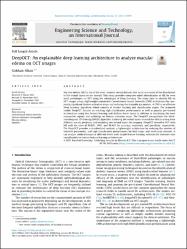| dc.contributor.author | Altan, Gökhan | |
| dc.date.accessioned | 2022-11-28T11:05:59Z | |
| dc.date.available | 2022-11-28T11:05:59Z | |
| dc.date.issued | 2022 | en_US |
| dc.identifier.citation | Altan, G. (2022). DeepOCT: An explainable deep learning architecture to analyze macular edema on OCT images. Engineering Science and Technology, an International Journal, 34, art. no. 101091.
https://doi.org/10.1016/j.jestch.2021.101091 | en_US |
| dc.identifier.uri | https://doi.org/10.1016/j.jestch.2021.101091 | |
| dc.identifier.uri | https://hdl.handle.net/20.500.12508/2340 | |
| dc.description.abstract | Macular edema (ME) is one of the most common retinal diseases that occur as a result of the detachment of the retinal layers on the macula. This study provides computer-aided identification of ME for even small pathologies on OCT using the advantages of Deep Learning. The study aims to identify ME on OCT images using a lightweight explainable Convolutional neural networks (CNN) architecture by composing significant feature activation maps and reducing the trainable parameters. A CNN is an effective Deep Learning algorithm, which consists of feature learning and classification stages. The proposed model, DeepOCT, focuses on reaching high classification performances as well as popular pre-trained architectures using less feature learning and shallow dense layers in addition to visualizing the most responsible regions and pathology on feature activation maps. The DeepOCT encapsulates the block-matching and 3D filtering (BM3D) algorithm, flattening the retinal layers to avoid the effects arising from different macula positions, and excluding non-retinal layers by cropping. DeepOCT identified OCT with ME with the rates of 99.20%, 100%, and 98.40% for accuracy, sensitivity, and specificity, respectively. The DeepOCT provides a standardized analysis, a lightweight architecture by reducing the number of trainable parameters, and high classification performances for both large- and small-scale datasets. It can analyze medical images at different levels with simple feature learning, whereas the literature uses complicated pre-trained feature learning architectures. | en_US |
| dc.language.iso | eng | en_US |
| dc.publisher | Elsevier | en_US |
| dc.relation.isversionof | 10.1016/j.jestch.2021.101091 | en_US |
| dc.rights | info:eu-repo/semantics/openAccess | en_US |
| dc.subject | Convolutional neural networks | en_US |
| dc.subject | Deep learning | en_US |
| dc.subject | DeepOCT | en_US |
| dc.subject | Macular edema | en_US |
| dc.subject | Optical coherence tomography | en_US |
| dc.subject.classification | Segmentation | |
| dc.subject.classification | Macular Edema | |
| dc.subject.classification | Speckle Noise | |
| dc.subject.classification | Engineering | |
| dc.subject.classification | Clinical & Life Sciences - Ophthalmology - Diabetic Retinopathy | |
| dc.title | DeepOCT: An explainable deep learning architecture to analyze macular edema on OCT images | en_US |
| dc.type | article | en_US |
| dc.relation.journal | Engineering Science and Technology, an International Journal | en_US |
| dc.contributor.department | Mühendislik ve Doğa Bilimleri Fakültesi -- Bilgisayar Mühendisliği Bölümü | en_US |
| dc.identifier.volume | 34 | en_US |
| dc.relation.publicationcategory | Makale - Uluslararası Hakemli Dergi - Kurum Öğretim Elemanı | en_US |
| dc.contributor.isteauthor | Altan, Gökhan | |
| dc.relation.index | Web of Science - Scopus | en_US |
| dc.relation.index | Web of Science Core Collection - Science Citation Index Expanded | |
















